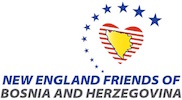American Islamic Congress cooperated with New England Friends of Bosnia and Herzegovina to organize AIC Intercultural Mixer: Discover Bosnia on April 27th, 2012, at the AIC Cultural Center on Newbury Street in Boston. The event attracted a diverse crowd of over 150 Bosnians, and friends of BiH. Mr. Haris Jusufbegovic welcomed the guests on behalf of NEFBiH. The evening program included an art exhibition by Dr. Azra Aksamija, in cooperation with Mr. András Riedlmayer, traditional Bosnian music sevdah played by members of NEFBiH, as well traditional Bosnian food and refreshments. Mr. András Riedlmayer and a fellow attendee Mr. Jeff Spurr have shown an exceptional respect and support for Bosnia and Herzegovina, and its people. New England Friends of Bosnia and Herzegovina recognizes their tremendous effort to preserve Bosnian culture, identity and heritage. On behalf of all the members and the Organizing Committee, we would like to take a moment to thank them for all of their efforts. Guests were also able to participate in the special interactive food project titled “Digesting Dayton” (for more information, please see below). Thank you to all the community members and businesses that co-sponsored the event: Fall River Florist Supply, Five Star European Market, Sabur Restaurant and Elma Food Market. Special thank you goes to Mr. Kemal Colakhodzic for his generous monetary contribution for this event. To learn more about American Islamic Congress, please visit www.aicongress.org.
Dr. Azra Akšamija is a Sarajevo born artist and architectural historian, at the time Assistant Professor in the Visual Arts at MIT’s Art, Culture and Technology Program. She holds undergraduate and graduate degrees in architecture from the Technical University Graz, Austria (Dipl.Ing. in 2001) and Princeton University (M.Arch. in 2004), and received her Ph.D. from MIT (History Theory and Criticism of Art and Architecture / Aga Khan Program for Islamic Architecture) in 2011. Her recent projects focused on the representation of Islamic identities in the West, spatial mediation of identity politics, and cultural pedagogy through art and architecture.
András Riedlmayer directs the Documentation Center of the Aga Khan Program for Islamic Architecture at Harvard's Fine Arts Library. A specialist in the history and culture of the Balkans, he has spent the past decade documenting the destruction of cultural heritage in the wars in Bosnia and in Kosovo. He has testified about his findings as an expert witness before the U.N. war crimes tribunal and before the International Court of Justice in The Hague. He is also cofounder of the Bosnian Manuscript Ingathering Project, an effort to trace and recover still-extant microfilms and photocopies representing some of the thousands of unique manuscripts and historical documents that were destroyed when archives and libraries in Bosnia were burned by nationalist extremists during the 1990s.
The “Digesting Dayton” buffet represented an interactive artistic intervention conceived by Azra Aksamija and set up in collaboration with AIC. All attendees were invited to participate. A map of Bosnia & Herzegovina was sown onto the tablecloth. The food was arranged along the internal political borders of BiH, that is: the border of the Serb Republic and the cantons of the Bosniak-Croat Federation, as they were settled in the Dayton Peace Agreement in ‘95. Paradoxically, the American-brokered compromise made for the sake of peace was intended to maintain Bosnian unity, but in practice it also induced an internal political fragmentation of the country. While these internal lines of separation that were created through the genocide and the “ethnic cleansing,” the signing of the Dayton Peace Agreement de-facto legalized the artificial division of the Bosnian population along clear-cut ethnic and national categories. As guests enjoyed the tasty treats, they were also symbolically “eating away” the borders of B & H. Visitors originating from Bosnia were invited to stick a toothpick on this tablecloth-map, marking the place that they come from. This interactive engagement of the visitors was aimed to result in artwork that is shaped through collective action, rendering visible a map of Bosnian diasporic community in the Boston area.
















